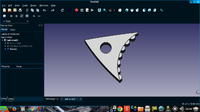Concept for closed loop belt for Delta Printer
Project developed by Ngtanike (talk) 05:35, 11 December 2015 (PST)
Template:Statusboxtop Template:Status-design You can help Appropedia by contributing to the next step in this OSAT's status. Template:Boxbottom
Abstract
Using a closed loop belt has significant advantages over an open loop belt.
- Carriage assembly can be much simpler.
- The printer can be used for other purposes involving rotatory motion, instead of linear, such as centrifuge, tensile testing, etc.
The proposed system uses ninjaflex to print a belt extension piece which will enable the printer to work in 2 modes: 3D printer mode and free rotation mode.
- This system converts an open loop to a closed loop.

Materials Needed
- Ninjaflex or similar flexible filament.
Items to 3D Print
- A belt extension piece of ninjaflex to be glued to the belt.
- Spacer for carriage
Thingiverse link http://www.thingiverse.com/thing:1193826/#files
Instructions
- Print the belt extension piece of ninjaflex with high accuracy and 100% infill.
- Firmly glue one side of the belt to the belt extension piece.
- Pull the belt tight around the pulleys.
- Clamp the belt and the belt extension piece together and glue them.
- Inset spacer between the belt extension piece and the carriage.
- Fix position using a bolt.
Notes
Make sure to leave a little or no space after the teeth of the belt while sticking to the inside of the belt extension piece, i.e make sure that a tooth just sticks out from the belt. This will ensure better mating with the pulley.
Disadvantages of this method are:
- The belt extension piece requires high resolution which is expensive to manufacture.
- A regular 3d printed piece will not mate perfectly and might slip.
- Gluing the belt means that it cannot be reused for printing. A new belt would be required every time the belt is removed.
- Theoretically, the belt cannot be perfect, the trick is to make sure that the disadvantages do the least harm
Future work and improvements
- A lot of changes have to be made to the athena to make sure that the belt can complete a full rotation and act as closed loop.
- A smaller radius on the belt extension piece would ensure better mating with the pulley, however, printing a component that small did not show positive results due to printer resolution.
- A belt of lower width, or a wider pulley will enable the use of a clamp in the belt extension piece. This would eliminate the need to glue the belt.
- Low tension applications should not have any problems with this system.